Top Stories
Combat Mold and Mildew: Effective Strategies for a Healthier Home

Mold and mildew are not merely cosmetic issues; they are indicators of underlying moisture problems in homes and buildings. As excess moisture accumulates, these fungi can thrive, leading to potential health risks and structural damage. Understanding how to prevent mold and mildew growth is essential for maintaining a safe and healthy living environment.
Understanding Mold and Mildew
Mold is a type of fungus that forms thread-like structures, known as hyphae, and spreads rapidly in warm, damp conditions. It typically appears in various colors, including black, green, or blue, and can be found on walls, ceilings, or under sinks. In contrast, mildew is a surface-level fungus that appears powdery, often in white or grey, and commonly grows on shower tiles, fabrics, and other damp surfaces.
While mildew is generally easier to clean, both mold and mildew can contribute to poor indoor air quality. They can trigger respiratory issues, particularly in individuals with allergies, asthma, or compromised immune systems. Neglecting these fungi can also result in extensive cleaning or costly repairs, making it vital to take preventive measures.
Preventing Growth Through Moisture Control
The critical factor that enables mold and mildew to thrive is moisture. According to health experts, controlling humidity levels is key to preventing these fungi from taking root. Keeping indoor humidity below 60 percent can significantly reduce the chances of mold and mildew growth. Simple adjustments, such as using dehumidifiers and ensuring proper ventilation in bathrooms and kitchens, can effectively manage moisture levels.
Investing in smart tools can further aid in moisture control. Options like air purifiers and moisture absorbers can create a healthier indoor environment. For instance, products like bamboo charcoal bags, available for as little as $5.39, are effective odour absorbers that also help regulate humidity.
Regular maintenance is another essential step. Homeowners should promptly address leaks and water stains, ensuring that any damp areas are dried quickly. Routine inspections of less visible spaces, such as attics and basements, can help catch moisture issues before they escalate.
By focusing on moisture control and implementing simple strategies, individuals can create a cleaner, healthier home. Prevention is often more cost-effective than repair, and with a little effort, homeowners can avoid the health risks associated with mold and mildew.
In summary, addressing mold and mildew proactively can save considerable stress and expense in the long run. By understanding their implications and taking decisive action against moisture build-up, residents can ensure a safe and pleasant living space for themselves and their families.
-

 Politics4 weeks ago
Politics4 weeks agoSecwepemc First Nation Seeks Aboriginal Title Over Kamloops Area
-

 World5 months ago
World5 months agoScientists Unearth Ancient Antarctic Ice to Unlock Climate Secrets
-

 Entertainment5 months ago
Entertainment5 months agoTrump and McCormick to Announce $70 Billion Energy Investments
-

 Science5 months ago
Science5 months agoFour Astronauts Return to Earth After International Space Station Mission
-

 Lifestyle5 months ago
Lifestyle5 months agoTransLink Launches Food Truck Program to Boost Revenue in Vancouver
-

 Technology3 months ago
Technology3 months agoApple Notes Enhances Functionality with Markdown Support in macOS 26
-

 Lifestyle3 months ago
Lifestyle3 months agoManitoba’s Burger Champion Shines Again Amid Dining Innovations
-

 Top Stories2 months ago
Top Stories2 months agoUrgent Update: Fatal Crash on Highway 99 Claims Life of Pitt Meadows Man
-

 Politics4 months ago
Politics4 months agoUkrainian Tennis Star Elina Svitolina Faces Death Threats Online
-

 Sports5 months ago
Sports5 months agoSearch Underway for Missing Hunter Amid Hokkaido Bear Emergency
-

 Politics5 months ago
Politics5 months agoCarney Engages First Nations Leaders at Development Law Summit
-

 Technology5 months ago
Technology5 months agoFrosthaven Launches Early Access on July 31, 2025








